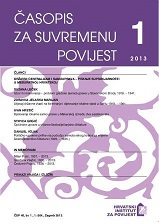Političko-upravne prilike na području samoborskog kotara za vrijeme šestosiječanjske diktature (1929.–1935.)
POLITICAL AND ADMINISTRATIVE SITUATION IN THE SAMOBOR DISTRICT DURING THE 6TH OF JANUARY DICTATORSHIP (1929 – 1935)
Author(s): Danijel VojakSubject(s): History
Published by: Hrvatski institut za povijest
Keywords: Samobor; The 6th of January Dictatorship; Repression; Municipal Self-Government; Croatian Peasant Party
Summary/Abstract: The 6 January Dictatorship in the Samobor districts was introduced without a (significant) resistance of the population and opposition politicians (especially among members of Croatian Peasant Party/HSS). Holders of the new government have become loyal state servants in the municipal and county governments. They relied on repressive gendarmerie and police which included monitoring and reporting of national political and judicial bodies of prominent opposition politicians, and carefully filing and punish any violations of the law (such as insults King, hanging the “tribal” flag, etc.). In Samobor municipality it was appointed Pavao Cesar and several representatives whit the aim of supporting new state unification policy forbidding nationalism and political opposition. After the death of Aleksandar I Karađorđević in October 1934th state and local government didn’t succeed in repressing the political activity of HSS which had won on parliamentary election in May 1935. This formally ended the dictatorship in the Samobor district. Soon after that HSS had won on municipally election in October 1936.
Journal: Časopis za suvremenu povijest
- Issue Year: 45/2013
- Issue No: 1
- Page Range: 119-154
- Page Count: 36
- Language: Croatian

